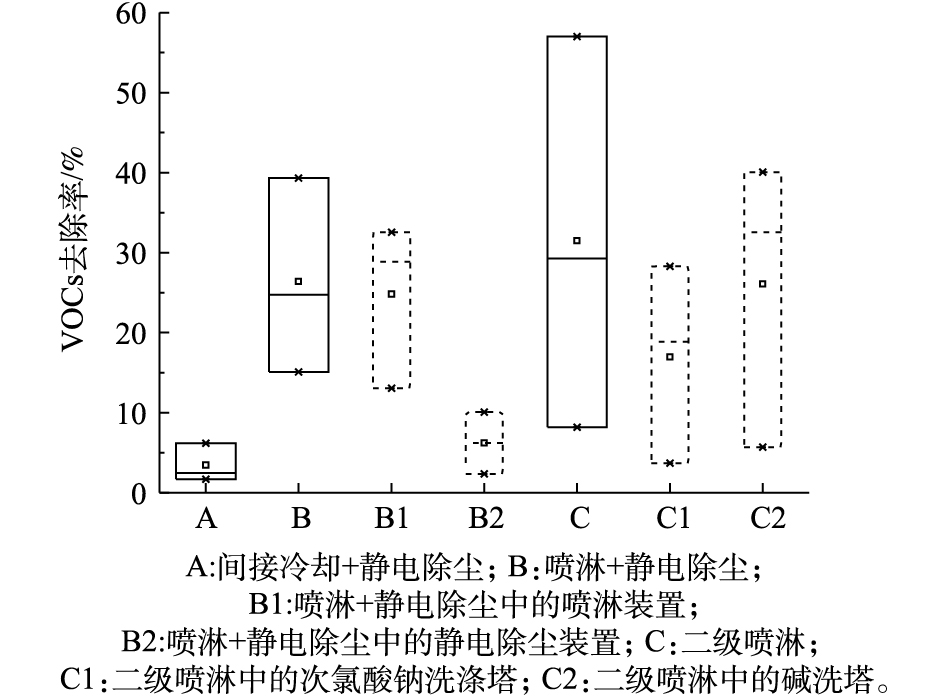-
我国是印染大国,纺织印染行业是我国的支柱产业之一。2016年,我国规模以上印染企业印染布产量9.7×1010 m[1],在环保压力提升的背景下,中小企业因环保压力被动停产或寻求兼并,印染行业的区域集中度逐渐提高。我国印染行业主要集中在东部沿海地区,截至2015年,浙江地区已经汇集了全国接近63%的印染行业产能[2]。印染行业在带来巨大经济利益的同时,也带来了非常严重的环境污染问题[3],尤其是VOCs的污染问题。印染行业作为纺织行业的关键行业,生产过程中需要使用大量挥发性助剂,目前我国印染助剂年使用量为1.2×105 t[4],助剂的大量使用导致了严重的VOCs污染,2012年,长江三角洲区域纺织印染行业VOCs总排放量达到7.5×104 t[5]。VOCs与PM2.5的形成有密切关系,也是光化学烟雾的源头,如果未经治理的印染废气大量排放,会直接影响大气环境,部分有毒VOCs长期累积排放会直接影响企业职工的身体健康,容易造成职工的呼吸道疾病,甚至发生癌变,还会影响周边居民的生活质量[6],印染行业的VOCs排放问题也因此获得重点关注。我国于2015年推出了《纺织染整工业大气污染物排放标准》[7],其中关于VOCs的各项标准相比于之前沿用的《大气污染物综合排放标准》[8]和《恶臭污染物排放标准》[9]更加严格。目前,我国缺乏印染废气尤其是VOCs的产生特征及去除特性研究,这增加了印染废气的处理难度,因此,研究印染行业VOCs产生特征是十分必要的。
本研究以浙江省内一家典型的印染企业为研究对象,着重对该企业内3个分厂进行废气监测,以了解其VOCs的产生特征,为进一步了解印染VOCs产生特征以及提高印染废气治理效果提供参考,为解决印染VOCs污染提供技术支持。
全文HTML
-
本研究选取了浙江省印染企业高度集聚区的一家典型印染企业。该企业每年印染布产量达7.8×107 m,每年印染布产量为2.5×104 t。本研究对该企业3个印染分厂(产品分别为针织布、梭织布以及化纤涤纶布,编号为A分厂、B分厂、C分厂)及印染污水站进行VOCs产生特征的探究。有组织废气源主要包括定型机、配料间及污水站。该企业对A分厂和B分厂定型机废气采用“间接冷却+静电除尘”装置进行治理,对C分厂定型机废气采用“水喷淋+静电除尘”装置进行废气治理,对各分厂配料间废气及污水站废气采用“次氯酸钠洗涤+碱洗”二级喷淋装置进行治理。
-
印染行业的工艺流程主要包括胚布准备、前处理、后整理和成品4个阶段,各个印染企业使用的工序及原料会有所不同,但是整体工艺流程[10]相似。
该企业各废气源如图1所示。该企业共有45台定型机,定型机废气主要来自胚布表面溶剂的受热挥发[11];配料间包括配料车间和染料仓库,配料间产生的废气主要是来自于配料过程中助剂染料的挥发,也包括染料仓库中存放的助剂及染料的自然挥发;该企业污水站恶臭气体的主要产生单元包括调节池、水解酸化池及污泥浓缩池,所产生的废气经负压管道收集后经过处理直接排放。故选择以上3个有组织废气源作为废气监测点。经过现场调研了解到,印染企业中无组织废气主要来自设备运行以及配料间的配料过程,所以选取染色定型车间以及定型车间进行无组织废气特征测定。同时,污水站内未封闭的处理单元也会产生一定的无组织废气,故污水站无组织废气测定点选择好氧池、厌氧池、初沉池。在无组织废气测定过程中,车间内依据印染设备不同距离各取3个点位进行测定,对污水站各处理单元附近上下风向各取3个点位进行测定。针对该企业各分厂的废气处理装置,测定点位选取在各废气装置的进出气口,监测指标为VOCs浓度及H2S浓度。
-
废气测定指标包括温度、湿度、流量、VOCs浓度、VOCs组分。其中温度采用Testo 905-T1-温度计测量。湿度采用Testo 605-H1-温湿度仪测量。废气流量通过废气气速与废气排风管横截面积计算,流速使用Testo 416 -精密型叶轮风速仪进行测量。VOCs浓度采用PhoCheck Tiger VOC检测仪进行现场测定。VOCs采样方法采用固相微萃取采样(SPME),采样点设在各测定点尾气收集管道内,将SPME萃取头伸入废气管道内部,吸附采样时间为10 min。VOCs组分测定采用国家标准方法(HJ 73-4-2014),即“SPME+气相色谱质谱联用仪(GC-MS)”检测方法[12]。采用安捷伦气相色谱/质谱联用仪,将SPME萃取头插入进样口,吸附在萃取头上的VOCs物质随着高纯氦气(纯度99.999%)进入HP-5ms色谱柱(30 m×0.25 mm×1 μm,Agilent Technologies,美国)中进行分离。气体经分离后进入ECD检测器、FID检测器、质谱监测仪,依据各物质停留时间以及峰面积,对VOCs组分进行定性半定量分析。针对废气处理装置增加了进出气H2S浓度指标的测定,采用HND88式便携式H2S检测仪进行检测分析。
1.1. 调研企业概况
1.2. 采样及测定点位
1.3. 分析方法
-
由于染色和漂洗过的纺织品需要在定型机内进行烘干拉幅和热处理[13],同时纺织品上携带的水分受热大量蒸发,所以定型机所产生的废气平均温度和湿度较高,平均温度为135 ℃,相对湿度已饱和;配料间内无加热装置,产生废气的温度为24 ℃,与室温相近,废气湿度随配料间配料时间的改变而变化;污水站废气温度约为26 ℃,湿度为60%~70%。
该企业各有组织废气的废气特征如表1所示,定型机、配料间及污水站产生的有组织废气流量分别为8.6×105、7.4×104、2.8×104 m3·h−1,产生的VOCs平均浓度分别为14.7、9.0和14.9 mg·m−3。《纺织染整工业大气污染物排放标准》对VOCs限值为40 mg·m−3,《大气污染物综合排放标准》对非甲烷总烃的限值为120 mg·m−3,排放速率限值为15 kg·h−1,各废气源的VOCs浓度均满足排放标准的要求。
由于该印染企业配料间及污水站废气产生量较低,且配料间为非连续运行模式,每天工作时间不定,平均为3 h,所以印染企业生产过程中,定型机是最大的VOCs产生源。通过调研了解到,企业每年运行约300 d,定型机和污水站每天运行约20 h,配料间每天工作约3 h,由此计算得该企业每年定型机总VOCs产生量约为76.8 t,配料间VOCs年产生量约为0.6 t,污水站VOCs年产生量为2.5 t,企业每年VOCs产生总量约为79.9 t,印染过程中VOCs产生量约为31.9 kg·t−1 (产品)。
各无组织废气源的VOCs浓度如图2所示。染色车间VOCs平均浓度在0.16 mg·m−3左右。相比染色车间,定型车间内的VOCs浓度要高得多,浓度为0.1~1.9 mg·m−3,平均浓度约为0.66 mg·m−3,污水站的VOCs浓度为0.1~1.1 mg·m−3,平均浓度约为0.59 mg·m−3。定型车间和污水站产生无组织VOCs浓度具有区域性,不同测定点VOCs浓度差异较大。
-
1)定型机产生的VOCs组分特征。在热定型过程中,纤维布料上残留的有机物受热挥发,产生大量VOCs气体,VOCs气体组分易受到定型过程中助剂成分的影响。各分厂定型机VOCs组分如图3所示。A分厂定型机所产生的VOCs中氟代烃为主要物质,包括占比为22.7%的五氟丙酸三十八烷酯以及占比为23.3%的五氟丙酸三十烷酯。这是由于印染行业中经常会使用含氟的有机润滑剂(如氯化三氟乙烯、氟硅类、二酯、矿物油等物质),染色过程也会使用含氟的活性染料[14],其他VOCs还包括烷烃、异喹啉等。B分厂定型机的VOCs与A分厂定型机VOCs组分类似,同样是以卤代有机物为主,卤代有机物中的卤素为氯与氟,典型组分包括占比为12.2%的五氟丙酸三十八烷酯,以及占比为3.7%的三氯甲烷,其他VOCs组分包括乙二醇丁醚、二十一烷等物质,乙二醇醚类是印染过程常用的有机溶剂[15]。相关毒理学研究[16]表明,乙二醇醚类对人具有血液毒性、肝肾毒性等的不良影响。C分厂定型机废气VOCs检测出的成分以苯系物为主,VOCs中典型污染物为苯甲酸苄酯,约占为72%,苯甲酸苄酯主要用作乙酸纤维和硝酸纤维的溶剂,塑料增塑剂[17]。C分厂定型机VOCs的成分与A、B分厂有很大差异,主要原因为C分厂的加工产品为化纤布,在化纤布印染过程中会大量使用苯类助剂[18]。
2)配料间产生VOCs的组分特征。配料间所挥发出的VOCs组分取决于使用助剂的成分及挥发性,配料间非连续的工作时间及不同的配料方式也易对VOCs的组分产生影响,所以B分厂及C分厂的VOCs组分测定目的仅为确定印染配料间的典型VOCs组分,各分厂配料间组分如图4所示。B分厂配料间检测出的VOCs组分主要包括苯系物、卤代烃,VOCs组分与B分厂定型机测出的组分十分类似,如图4所示,VOCs主要包括含氟有机物、苯甲酸苄酯等物质。C分厂配料间所产生VOCs的组分十分复杂,VOCs主要为苯系物,主要成分包括蒽、甲基萘、甲基菲、甲基芴等。
印染企业配料间 VOCs 与定型机所产生 VOCs 组分类似,表明定型机所挥发出的 VOCs 组分受使用助剂种类影响较大,所以降低定型机产生的 VOCs 应该重点关注印染配料所使用的原料助剂的种类。
3)污水站产生VOCs的组分特征。印染企业耗水量大,且其中含有高浓度的染料、印染助剂等有机物,污水处理过程中挥发出的VOCs组分也因为污水中的多种溶剂变得十分复杂[19],VOCs的成分特征如图5所示。印染污水处理过程所产生的VOCs包括蒽、乙醛、甲基辛基醚、十八腈等物质,甲基辛基醚占总VOCs比例为12%;其余VOCs包括1-醋酸-8-甲基-9-十四烯酯,占比为33.50%,蒽占比为16.30%。蒽类芳香族有机化合物同样也是印染污水中的主要污染物[20],十八腈常用作印染布料的表面活性剂[21]。
-
1)印染VOCs去除特性。该企业针对印染废气安装了“间接冷却+静电除尘”、“喷淋+静电除尘”和“次氯酸钠洗涤+碱洗”3类处理系统。根据卢滨等[22]对杭州市工业源VOCs治理设施的调研结果,在杭州市的纺织印染企业的废气治理设施中,“静电除尘”和“水/酸/碱吸收”占比分别为46.47%和20%。说明静电除尘及“水/酸/碱吸收”是印染企业常用的废气治理设施,对该企业各废气处理装置的测定结果具有一定的代表意义。各处理装置对VOCs的处理效果如图6所示。“间接冷却+静电除尘”装置对定型机的VOCs去除率仅为2%~6%,“水喷淋+静电除尘”装置对VOCs去除率为15%~40%,其中“水喷淋”阶段对VOCs去除率较高,去除率为13%~32%,水喷淋之后的静电除尘装置对VOCs去除率依然很低,表明印染企业增设的静电除尘装置对VOCs几乎没有去除能力。“次氯酸钠洗涤+碱洗二级喷淋”装置对VOCs具有一定的去除效果,但是各分厂配料间所挥发出的VOCs组分不同,喷淋装置对VOCs处理率差异较大,去除率为8%~58%。二级喷淋装置对污水站的H2S仅有57%的去除率。
2)印染废气治理技术分析。定型机产生废气气量较大,不仅含有油滴等颗粒物,也含有浓度较低的VOCs污染物,虽然静电除尘装置对定型废气中颗粒物的去除具有一定效果,但是该技术对VOCs去除效果较差。企业单台静电除尘装置投资费用为2.5×106 元,企业总静电除尘装置每日所耗电费约为1.5×104 元,且每套装置每天需停止运行0.5 h进行人工清洁,存在着能耗较大,维护成本较高等问题,定型机废气处理技术的提升方向应该重点关注这几方面的问题。
配料间为非连续废气源,废气产生量较小,VOCs浓度较低,“次氯酸钠+碱洗”二级喷淋塔投资较低,配料间所配置的喷淋塔投资为2×105 元,且二级喷淋塔运行灵活,适合配料间的废气治理。
污水站所产生的废气量较大,目前使用的二级喷淋塔对于大风量的废气处理,存在药剂量消耗大、产生大量废液的问题,该企业污水站的二级喷淋装置每天需要消耗20 kg次氯酸钠溶液,10 kg碱液。生物法已经在各行业污水厂废气治理领域得到广泛应用,对于印染企业污水站所产生的大风量、低浓度VOCs的废气,可以选择生物法作为印染污水厂的废气治理技术,生物法对印染污水站所产生的苯系物、酯、醚、H2S等物质去除效果较好[23],污水站的VOCs的产生特征符合生物法的应用条件。
2.1. 废气温度、湿度、产生量及VOCs浓度
2.2. 各有组织废气源的VOCs组分特征
2.3. 印染VOCs去除特性及处理技术分析
-
1)定型机废气具有高温、高湿的物理特征,且定型机废气是印染废气的主要来源,该企业各废气定型机、配料间及污水站产生的有组织废气流量分别为8.6×105、7.4×104、2.8×104 m3·h−1,产生的VOCs平均浓度分别为14.7、9.0和14.9 mg·m−3。该企业每年总VOCs产生量可达79.8 t,经估算得,印染过程中VOCs产生量约为31.9 kg·t−1 (产品)。印染企业各车间无组织VOCs平均浓度较低,但是VOCs浓度分布具有区域性,需要对定型车间中VOCs浓度较高的区域增加相应的处理措施。因此,建议增大通风量,或者完善定型机废气收集系统。
2)印染行业VOCs成分复杂,且多为大分子物质,虽然不同分厂VOCs组分相差较大,但是各有组织废气源VOCs组分种类类似,VOCs中的苯系物主要包括苯甲酸苄酯、蒽类、喹啉类等,氟代有机物包括五氟丙酸酯及氯代有机物,印染VOCs主要来源于印染助剂的挥发。
3)印染企业各类废气处理装置对印染VOCs的去除效果差异较大,对于VOCs产生量最大的定型机,所采用的废气治理技术主体为静电除尘装置,静电除尘对印染VOCs去除率仅为2%~6%,说明印染企业针对定型机VOCs并未采取有效的控制措施,同时静电除尘装置存在着能耗大、维护成本高等问题。二级喷淋对配料间及污水站的VOCs去除率为8%~58%,对于印染污水站的VOCs治理,生物法是应用前景较好的技术。




 下载:
下载:






